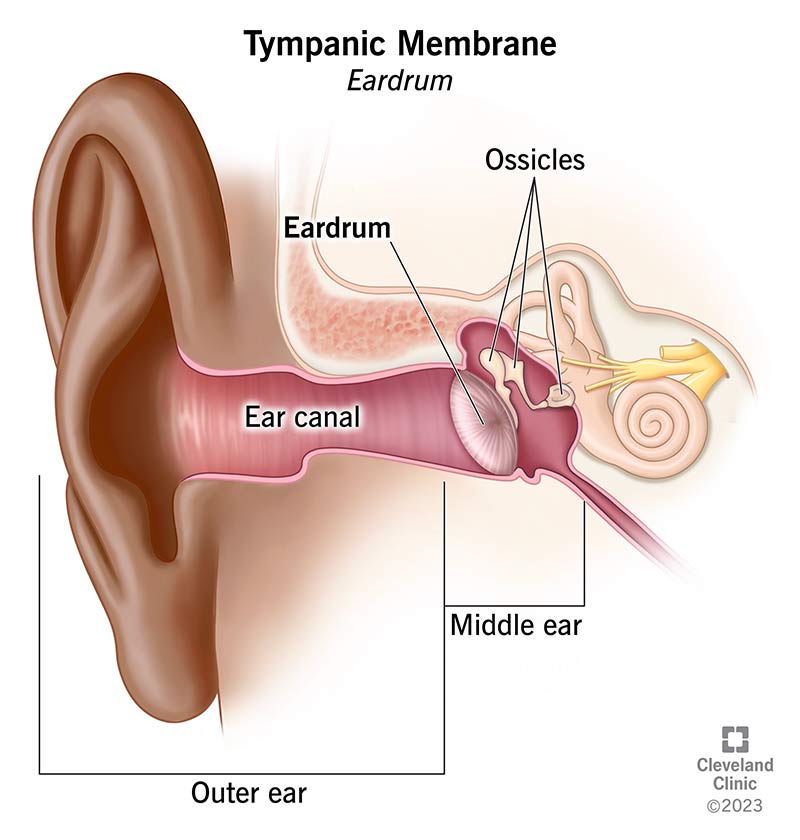Your tympanic membrane (eardrum) is a thin, circular layer of tissue that separates your outer ear from your middle ear. Your eardrum plays an important role in hearing. It also protects your middle ear from dirt, bacteria and debris.
Advertisement
Cleveland Clinic is a non-profit academic medical center. Advertising on our site helps support our mission. We do not endorse non-Cleveland Clinic products or services. Policy

“Tympanic membrane” is the medical term for eardrum. This thin, circular piece of tissue separates your outer ear and your middle ear.
Advertisement
Cleveland Clinic is a non-profit academic medical center. Advertising on our site helps support our mission. We do not endorse non-Cleveland Clinic products or services. Policy
Your eardrum plays a key role in hearing. Here’s how the process works:
Your eardrum is at the very end of your ear canal. It’s what separates your outer ear from your middle ear. Your ossicles (three tiny bones that help with hearing) are on the other side of your eardrum.
Your eardrum is a thin, circular piece of tissue that measures about 1 centimeter in diameter (about one-third the size of a U.S. penny). A healthy eardrum is pearly white or gray in color, but you can see through it. (Think of a foggy window or a stretched out piece of clear plastic.)
Your eardrum consists of connective tissue. There are three layers:
Advertisement
Common conditions that can affect your tympanic membrane (eardrum) include:
Ear injuries or infections can cause a hole in your eardrum (ruptured eardrum). An eardrum rupture can cause hearing loss, drainage or tinnitus (ringing in your ears).
Sometimes, a ruptured eardrum can heal on its own. In severe cases, you might need surgery to correct the issue.
Tympanosclerosis refers to scarring of your eardrum. This can happen following ear injuries or surgeries. Chronic, long-term ear infections can also cause tympanosclerosis.
People with tympanosclerosis often have chalky white eardrums due to scarring. In many cases, the scarring prevents sound from traveling through your ear properly.
The most common treatment for tympanosclerosis is tympanoplasty. During this procedure, a surgeon removes the scar tissue and repairs any damage to the bones in your middle ear.
The medical term for fluid behind your eardrum is “otitis media with effusion.” Some people call it glue ear. It happens when your eustachian tubes (the tubes that connect the inside of your ears to the back of your throat) become blocked or swollen.
Fluid can build up behind your eardrum following an ear infection. But allergies and irritants (like cigarette smoke) can also cause it.
In many cases, the fluid behind your eardrum will clear on its own. If it doesn’t go away, you may need antibiotics. If the issue lingers for more than six months, you may need ear tubes.
Your eardrum could become infected following a middle ear infection or an eardrum rupture. An infected eardrum can cause symptoms like ear pain, hearing loss, vertigo and ringing in your ears.
Many infected eardrums heal on their own. But if your symptoms linger for more than a couple of weeks, you might need oral antibiotics or antibiotic ear drops.
Properly caring for your ears can help keep your eardrums healthy. Here are some suggestions:
Your eardrum is in your middle ear. It sits at the very end of your ear canal, just in front of your ossicles (the tiny bones that help with hearing).
Advertisement
When sound waves reach your eardrum, it vibrates. This vibration then sends signals to your ossicles (the tiny bones in your middle ear), and then to your inner ear, where your auditory nerve transmits this information to your brain.
In many cases, a torn or damaged eardrum heals on its own in a few weeks. But if your symptoms worsen or last more than a few weeks, tell a healthcare provider.
In many cases, yes. Your eardrum can usually repair itself within a few weeks.
You can’t see someone’s eardrum with the naked eye. But your healthcare provider can use an otoscope to look at your eardrum. An otoscope is a lighted handheld instrument that magnifies your ear canal and eardrum.
Without your eardrum, everything would sound muffled. People with ruptured eardrums usually have some hearing loss until the membrane heals.
Your eardrum (tympanic membrane) is essential for proper hearing function. Ear infections and injuries can damage your eardrum and cause ear pain, tinnitus, drainage and hearing loss. The good news is that your eardrum can heal on its own in many cases — and damage is usually temporary. But if you have worrisome symptoms that linger, let your healthcare provider know so they can help you correct the issue.
Advertisement
If you have conditions affecting your ears, nose and throat, you want experts you can trust. Cleveland Clinic’s otolaryngology specialists can help.

Last reviewed on 01/24/2023.
Learn more about the Health Library and our editorial process.